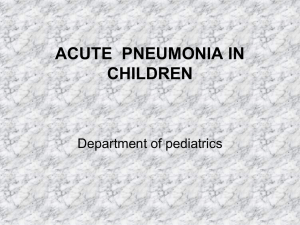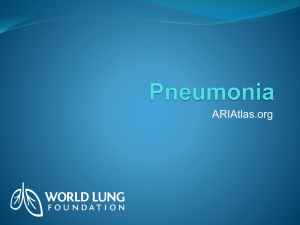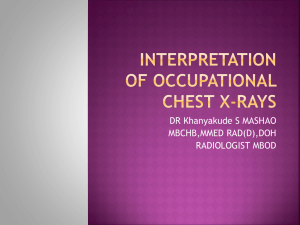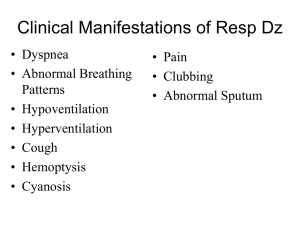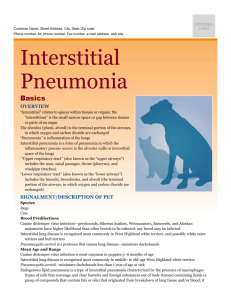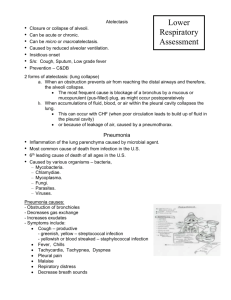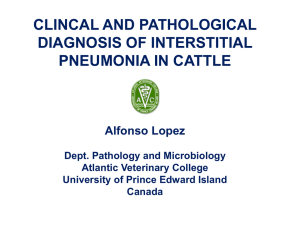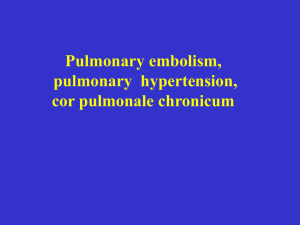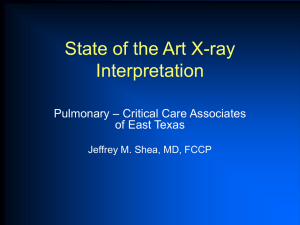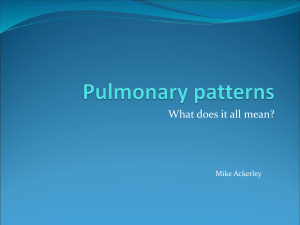Imaging of the thorax
advertisement
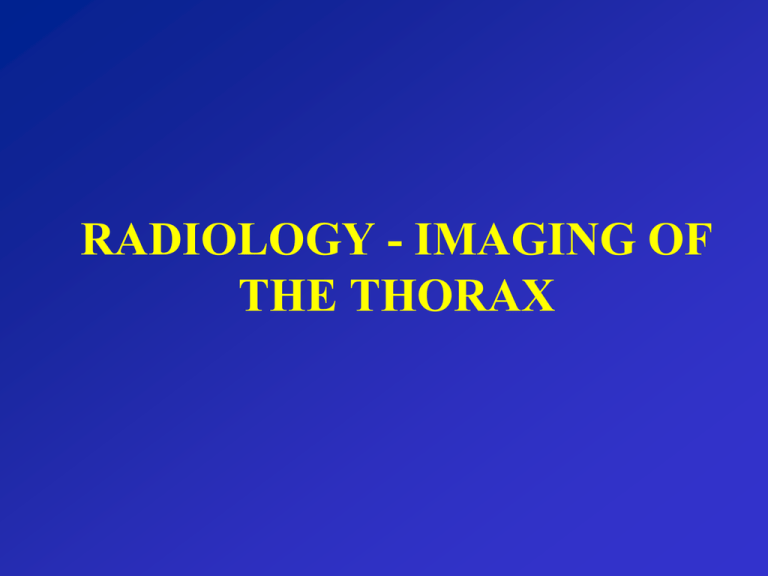
RADIOLOGY - IMAGING OF THE THORAX THE CHEST METHODS OF EXAMINATION Radiography Standard examination : - PA + lateral projection; - tube-film distance – 1,5 m to minimize divergent distorsion and magnification; - full inspiration. Apical lordotic view – - is used to see diseases in the pulmonary apices, which may be obscured by the clavicle and the first rib; - AP wiew with the patient leaning backward on the cassette holder. Supine radiographs – intensive care units. DIGITAL RADIOGRAPHY THE CHEST METHODS OF EXAMINATION Fluoroscopy –dynamic study of the cardiovascular system, diafragmatic motion. Disadvantage: high radiation dose. Bronchography – the study of the bronchial tree by means of the introduction of opaque material into the bronchi. Replaced by CT, fiberoptic bronchoscopy, brush biopsy, percutaneous biopsy Tomography – it is possible to examine a single layer of tissue and to blur the tissues above and below the level by motion (the tube and the film move in opposite directions). - replaced by CT. THE CHEST METHODS OF EXAMINATION Fluoroscopy 1933 2000 THE CHEST METHODS OF EXAMINATION Tomography Tub Rx Caseta/film THE CHEST METHODS OF EXAMINATION • Computed tomography – indications for the lung: • - Evaluation and staging of primary pulmonary neoplasms • - Detection of metastasis from non-pulmonary primary tumors. • Characterization of solitary pulmonary nodules as benign or malignant • Characterization of focal and diffuse lung disease for • diagnosis. THE CHEST METHODS OF EXAMINATION Computed tomography Indications for the mediastinum: - Causes of mediastinal widening - Staging of tumors that spread to the mediastinum - Characterization of mediastinal masses – cysts, solid, vascular, fat. Other indications: Pleura plaques, masses, loculated fluid, occult calcification, chest wall masses. High-resolution CT – evaluation of interstitial lung disease, bronchiectasis, emphysema, cystic lung disease. THE CHEST METHODS OF EXAMINATIONComputed tomografy 1975 1995 THE CHEST METHODS OF EXAMINATION Ultrasonography – fluid can be localized and differentiated from solid pleural masses; - mediastinal lesions in contact with the chest wall - lesions near the diafragm. THE CHEST METHODS OF EXAMINATION - Magnetic resonance imaging – indications: dissection of the aorta, aneurysm congenital and acquired heart conditions - intracardiac and paracardiac masses. - pericardial diseases. - brachial plexopathy. - diafragm and peridiafragmatic processes. - chest-wall lesions. - breast implants and breast masses. - Extention of the posterior mediastinal masses, especially those with intraspinal extension. MRI MAGNET Coils THE CHEST METHODS OF EXAMINATION Pulmonary and bronchial angiography – arterial or venous anomalies; thromboembolic disease. Scintigraphy Single Photon Emission Computed Tomography (SPECT ) - Tc 99m – iv injection - pulmonary perfusion - Xe gas is inhaled – pulmonary ventilation How to analyze the chest X-ray - Soft tissues - Bony thorax – ribs, clavicles, scapulae, thoracic vertebrae - Mediastinum - Lungs – hilum, vessels, apices - Pleura - Diafragm Roentgen observations must be correlated with all the available clinical information Gr.I Nodular opacities MILIARY tuberculosis Lesion in the mediastinum FELSON sign Lesion in the lung PNEUMONIA ATELECTASIS Diffuse opacities PLEURAL FLUID PLEURAL FLUID ATELECTASIS LINEAR OPACITIES EMPHYSEMA PNEUMOTHORAX DIFFUSE HYPERLUCENCIES 1 3 1 Chist hidatic 2 2 3 3 4 CIRCUMSCRIBED HYPELUCENCIES 1.Bulla 2. Aeric cyst 3. Cavity- TB 4. Cvity - cancer ABSCESS RUPTURED HYDATID CYST CHEST INFECTIONS Acute pulmonary infections 1. Lobar pneumonia – the organism reaches the periphery of the lung via the airways.Alveolar transudation is followed by migration of leucocytes into the alveolar fluid. 2. Bronchopneumonia (lobular pneumonia) – often observed in staphyloccocal infection of the lung. The disease originates in the airways and spreads to peribronchial alveoli. 3. Interstitial pneumonia – usually caused by a virus or a mycoplasma. 4. Mixed pneumonia – is a combination of lobar, bronchopneumonia and interstitial pneumonia. Pneumococcal pneumonia - Caused by S.pneumoniae. - roentgen findings can be observed within 6 to 12 hours after onset of symptoms. - Chest x-ray: - triangular opacity, the tip towards the hilum, the base towards the periphery of the lung. - all the elements in the diseased lobe may be affected except the large bronchi– “air bronchogram”. - Resolution is rapid if there are not complications – the opacity becomes more irregular and patchy, the intensity decreases. - Complications – delayed resolution, lung abscess, pleural effusion. Bronchopneumonia – staphyloccocal infection of the lung - It is the most commonly found in the very young or very old - The inflammatory disease does not cross septal boundaries the pattern of disease is discontinous or patchy. -Chest x-ray: -nodular opacities, 1-10mm, -poorly defined -with the center more opaque compared to the periphary. - It is particularly difficult to define and diagnose when it occurs as a complication in case of cardiac failure. Staphylococcal pneumonia – caused by Staphylococcus aureus - the infection may be primary in the lungs or secondary to a primary staphylococcal infection elsewhere in the body. - Usually occurs in debilitated adults or in the first year of life. - Consolidation rapidly spreads to involve a whole lobe and bronchi are obscured by exudate, so the air brohogram is rarely seen. - Abscess formation may occur; coalescense of small abscesses is frequent. - Pleural effusion, empyema and pneumothorax are frequent - Pneumatocele – a check-valve obstruction develops between the lumen of a small bronchus and the pulmonary parenchyma. - The disease is usually bilateral Interstitial pneumonia - usually caused by a virus or Mycoplasma pneumoniae (is responsible for a significant percentage of primary atypical pneumonia in children and young adults). - Roentgen findings: - Peribronchial or interstitial type – streaky densities extending from the hilum following the vascular markings. - Bronchopneumonic type. - Segmental or lobar types - Diffuse type – bilateral reticulo-nodular pattern DD - interstitial pneumonia bacterial pneumonia: - delay in radiological onset - lack of pleural involvement, - the tendency to clear in one area and to spread in another, bilaterality. Acute interstitial pneumonia : influenza Acute interstitial pneumonia Acute interstitial pneumonia COMPLICATIONS BRONHOPNEUMONIA SEGMENTAL PNEUMONIA Lung abscess - lung abscess = when an acute pulmonary infectious process breaks down to form a cavity. - Primary / secondary. -Chest x-ray - opacity confined to one segment, round, irregular borders. - When bronchial communication is established the fluid content of the cavity is replaced by air – hydro-aeric image with orizontal fluid level. -CT – Very useful to define the inner and outer walls, for complications (rupture into the pleural space). -Differential diagnosis: -early stage – pneumonia; -cavity – tbc, cancer, hydatid cyst, fungal infection TUBERCULOSIS - Transmitted by inhalation of infected droplets of Mycobacterium tuberculosis - Target population: patients of low economic scale, alcoholics, elderly, AIDS Primary TB Rancke (primary) complex : 1. Ghon focus – nodular opacity (1-7cm), irregular borders, non-homogeneous, low intensity, lower lobe 2. Lymphadenopathy – hilar and paratracheal, 95% 3. Lymphangitis – linear opacities Primary TB Evolution: - Healing - Fibrosis - Calcification - Cavitation Complications: - Miliary TB - TB pneumonia - TB bronchopneumonia - Pleural effusion Secondary TB - active disease in adults most commonly represents reactivation of a primary focus; the disease tends to be progressive - Typically limited to the upper lobes - No adenopathy Radiographic features •Early infiltrate – low intensity, poorly defined opacities •Cavitation – 40% •Fibro-caseous TB •Fibrotic TB – sharply circumscribed linear densities radiating to hilum; •Fibrothorax, tuberculoma Secondary TB Complications: 1. 2. 3. 4. 5. 6. Miliary TB Bronchogenic spread Bronchial stenosis Bronchiectasis Pneumothorax Pleural effusion – often loculated ASPERGILOMA AIDS Known routes of HIV transmission: - Blood and blood products - Sexual activity - In utero transmission - During delivery Clinical: - Lymphadenopathy - Incidental infections - Tumors: lymphoma, Kaposi sarcoma - Other manifestations: interstitial pneumonia, spontaneous pneumothorax, septic emboli AIDS Spectrum of chest manifestations: Nodules – Kaposi sarcoma (usually associated with skin lesions), septic infarcts, fungal infections (Cryptoccocus, Aspergillus) Large opacity: consolidation, mass – hemorrhage, pneumonia Linear or interstitial opacities – atypical pneumonia, Kaposi sarcoma Lymphadenopathy – Mycobacterial infections, Kaposi sarcoma, lymphoma Pleural effusion – Kaposi sarcoma, fungal infection, pyogenic empyema
